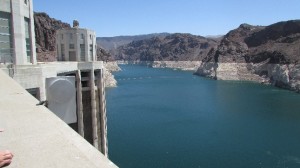
ASP in Las Vegas: Threats from Climate Change in the Desert
Podcast: Play in new window | Download
Subscribe: Apple Podcasts | RSS
On Wednesday and Thursday, June 11 and 12, representatives of the American Security Project visited Las Vegas, Nevada for a series of meetings, public events, and briefings on how climate change is affecting security, and how institutions in the region are planning for it.
Attending were BGen Stephen Cheney, USMC (ret.), ASP’s CEO and Lt. General Norman Seip, USAF (Retired). Cheney is the CEO of the American Security Project, and a 30 year veteran of the Marine Corps. Seip currently serves as an advisor to the Air Force. His most recent operational assignment was as the Commander of 12th Air Force (Air Forces Southern), Davis-Monthan Air Force Base, Ariz. As the Deputy Combined Forces Air Component Commander for U.S. Central Command, General Seip had a direct impact in supporting combat operations in operations Iraqi Freedom. Both are members of ASP’s Consensus for American Security. Andrew Holland, ASP’s Senior Fellow for Energy and Climate, and Porter Brockway, ASP’s events manager, rounded out the delegation.
Nellis Air Force Base Array
T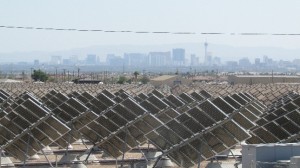 he first stop on the tour was Nellis Air Force Base, north of the “Strip.” While there, ASP toured the Nellis Solar Array. Taking up approaximately 140 acres of land, the array contains about 70,000 photovoltaic solar panels, with a peak power capacity of about 13 megawatts. When first installed in 2007, this was the largest solar array in the country, and one of the largest in the world. As a testament to how far solar has advanced in the last seven years, it is not even in the top 50 – it is not even the largest on a military base, with facilities in the Army’s Fort Huachuca and the Air Force’s Davis-Monthan in Arizona overtaking it. Only the week before, SunPower and NV Energy had announced a new plan to more than double the capacity of Nellis’ solar system.
he first stop on the tour was Nellis Air Force Base, north of the “Strip.” While there, ASP toured the Nellis Solar Array. Taking up approaximately 140 acres of land, the array contains about 70,000 photovoltaic solar panels, with a peak power capacity of about 13 megawatts. When first installed in 2007, this was the largest solar array in the country, and one of the largest in the world. As a testament to how far solar has advanced in the last seven years, it is not even in the top 50 – it is not even the largest on a military base, with facilities in the Army’s Fort Huachuca and the Air Force’s Davis-Monthan in Arizona overtaking it. Only the week before, SunPower and NV Energy had announced a new plan to more than double the capacity of Nellis’ solar system.
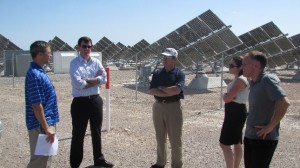 The Nellis Array provides about 25% of the electricity used by the base, and it has shown itself to be an example for the rest of the military in how to effectively reduce fossil fuel dependence while saving money and not harming operational effectiveness.
The Nellis Array provides about 25% of the electricity used by the base, and it has shown itself to be an example for the rest of the military in how to effectively reduce fossil fuel dependence while saving money and not harming operational effectiveness.
Las Vegas World Affairs Council
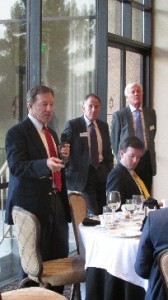 That evening, ASP presented to an expert audience put together by the Las Vegas Council on Foreign Affairs at the Spanish Trail Country Club. After an introduction from Stacy Standley, the former director of the WWF (Worldwide Fund for Nature) Living Planet Campaign, ASP presented to an audience of about 40 people a presentation about how climate change interacts with America’s security. It started with an outline of the science of climate change, then Generals Cheney and Seip noted how climate change is already affecting global security. Finally, General Cheney discussed how Las
That evening, ASP presented to an expert audience put together by the Las Vegas Council on Foreign Affairs at the Spanish Trail Country Club. After an introduction from Stacy Standley, the former director of the WWF (Worldwide Fund for Nature) Living Planet Campaign, ASP presented to an audience of about 40 people a presentation about how climate change interacts with America’s security. It started with an outline of the science of climate change, then Generals Cheney and Seip noted how climate change is already affecting global security. Finally, General Cheney discussed how Las 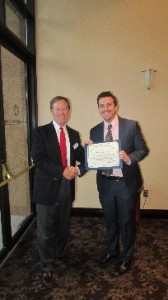 Vegas is clearly threatened by climate change, noting how drought and heat in the desert city were causing harm already. There were a number of questions focused on how climate change would impact America’s military force posture and our ability to intervene around the world.
Vegas is clearly threatened by climate change, noting how drought and heat in the desert city were causing harm already. There were a number of questions focused on how climate change would impact America’s military force posture and our ability to intervene around the world.
After the presentation, Vinny Spotleson, a staff member for Senator Harry Reid, gave a certificate of recognition to ASP for their work on this issue.
The entire presentation is available as a podcast, clicking above.
Bureau of Reclamation and the Hoover Dam
The following morning, ASP drove out to Boulder City, the home of the Bureau of Reclamation office that oversee the lower Colorado River Basin to discuss the effects of the ongoing drought on the Colorado River and the states the rely on its waters. They were accompanied by Heidi Kyser, a journalist with the Desert Companion, who wrote an excellent article, “We Want You to Join the Fight Against Climate Change” about it.
They met with Jennifer McCloskey, Assistant Regional Director for Reclamation’s Lower Colorado Region. As written in the recently released ASP Perspective Paper, Water Management in the American Southwest, Lessons for the Age of Climate Change, there is a large amount of redundancy built into the water systems of the region. So, as McCloskey explained, even though the drought of the last 14 years has been unprecedented in the historical record for the region, water delivery to customers has not been affected.
However, if the drought continues, that could change. Last year was the lowest release out of Lake Powell into Lake Mead since the lakes were created. The current level of Lake Mead is at about 1086 feet, and official shortage restrictions will go into effect once the lake reaches 1075 feet. That means that delivery of water will have to be curtailed to several of the junior states in the River basin, notably Arizona and Nevada. Reclamation estimates that the lake could go below 1075 feet as early at 2015. This will set up a series of legal conflicts between municipal and agricultural water users as well as between various states.
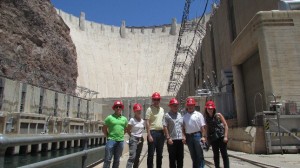 After the meeting, we made the short drive down from Boulder City – a drive that thousands of workers made during the depths of the Great Depression – to the Hoover Dam.
After the meeting, we made the short drive down from Boulder City – a drive that thousands of workers made during the depths of the Great Depression – to the Hoover Dam.
As you approach Hoover, one cannot help but be in awe of the size and scale of the achievement to build such a dam. On the tour of the Dam, the director of engineering showed how low the water level of Lake Mead had fallen. He noted that this not only affects the ability of Reclamation to deliver water, but it reduces the Dam’s ability to sell power.
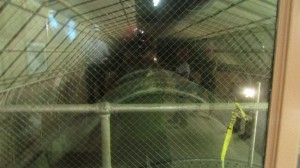 As the ASP delegation was in underground pipe room, one of the turbines turned on – you could feel the raw power that millions of gallons of water can deliver. One of the most interesting things is how this 1930s era of renewable power can work together with today’s renewables. The hydropower that Hoover Dam delivers is one of the best ways to integrate the variable power of renewables – when an electric utility needs power, it is easily “dispatchable” – so long as the water remains.
As the ASP delegation was in underground pipe room, one of the turbines turned on – you could feel the raw power that millions of gallons of water can deliver. One of the most interesting things is how this 1930s era of renewable power can work together with today’s renewables. The hydropower that Hoover Dam delivers is one of the best ways to integrate the variable power of renewables – when an electric utility needs power, it is easily “dispatchable” – so long as the water remains.
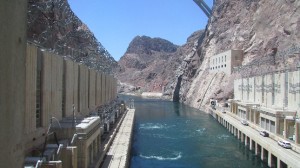 It is not an exaggeration to say that without Hoover Dam and the water supplied from Lake Mead, Las Vegas would not exist at anywhere near the size it does today. The Las Vegas region is challenge by climate change, more so than almost any other major American city. It is important that the city, state and federal government are aware of the challenges – and are preparing for it. Actions by Nellis Air Force Base show that the military can lead the way on addressing climate change, but the trip to Hoover Dam makes any visitor wonder how to rebuild the national consensus that Americans can do big things. Whereas we once built this series of great dams along a great river, enabling the West to be settled, we now cannot seem to find the consensus to do great things.
It is not an exaggeration to say that without Hoover Dam and the water supplied from Lake Mead, Las Vegas would not exist at anywhere near the size it does today. The Las Vegas region is challenge by climate change, more so than almost any other major American city. It is important that the city, state and federal government are aware of the challenges – and are preparing for it. Actions by Nellis Air Force Base show that the military can lead the way on addressing climate change, but the trip to Hoover Dam makes any visitor wonder how to rebuild the national consensus that Americans can do big things. Whereas we once built this series of great dams along a great river, enabling the West to be settled, we now cannot seem to find the consensus to do great things.

